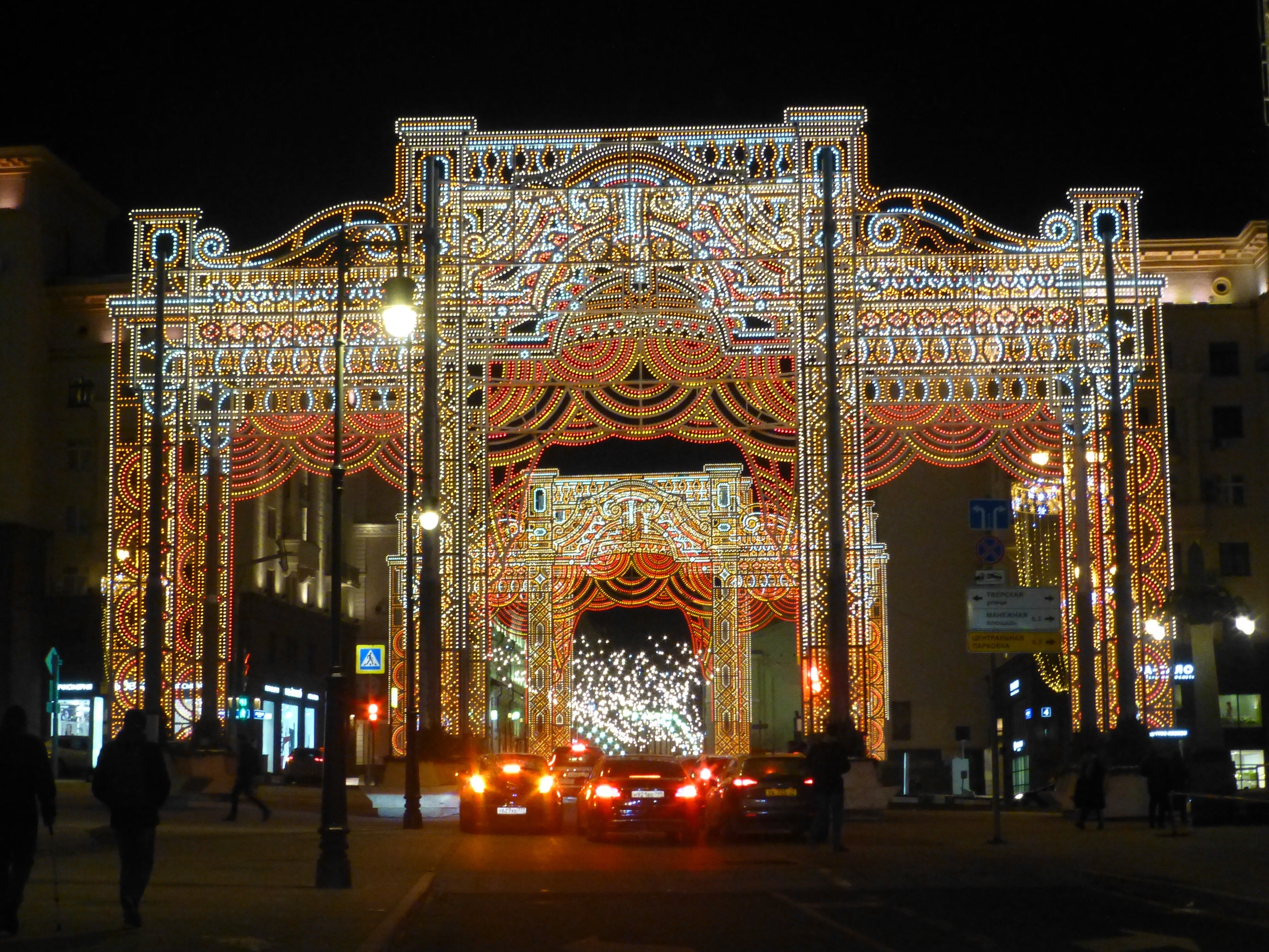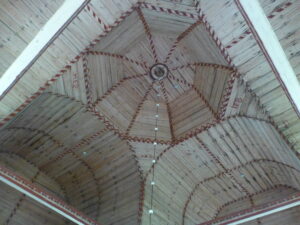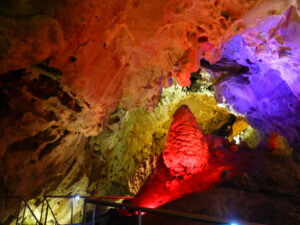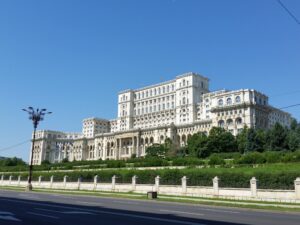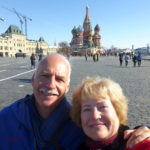
Waiting in Moscow for a few days before beginning a rail trip across Siberia, we were pleasantly surprised to see the old city in such fine shape. We had not been here for 25 years and 40 years respectively, and had heard reports of hard times for many of the people.
Here are some of our observations:
(NOTE: In the weeks after we left Moscow in the Trans-Siberian train, we made similar observations at other cities we visited and from people we talked with. For the average citizen, we heard, life can be a struggle to make ends meet, with many finding limited opportunities to work, especially the younger citizens despite their state-funded education. Yet the central cities, even in far eastern Siberia, show there is a great deal of wealth too, with good infrastructure, abundant sleek malls, renovations of old buildings and new construction. Irkutsk, near Mongolia, was in the poorest condition as a city, but it too often demonstrated grace and style. Other comments intrigued us. One woman lamented that Russia was losing its soul, as a Frenchman might also feel, because the farming villages were emptying out because the young and able kept moving to large cities. But that is a common phenomenon across the globe: cities vacuum up people looking for something better. Another person pointed out that Russians like to complain and grumble, “our biggest flaw,” but he maintained that enough is getting better in the country to be optimistic. That’s how we felt also.)
Infrastructure
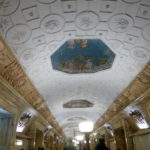
As we noted in our previous post, the Metro is still amazing – all 12 lines, with more to come, spreading far out to the suburbs. Impeccably clean at every station. Moderately priced at about a dollar per entrance, no matter how far you go, or how many connections you make. The veteran escalators still haul people briskly deep down below street level. Every 90 seconds, another one comes and goes. These trains, as with the longer haul ones, look old and purely functional from the outside, but comfortable and drably pleasant on the inside. However deep you go, you still have phone service, well wi-fi anyway provided free by the Metro system. All the stops are announced in Russian and English, a blessing since it is tough to see a station name from inside the cars. A bus network links the metros and goes farther afield.
Across town, free wi-fi is the norm. But many companies offer mobile phone service, and clearly most people in the central city have smartphones despite the hefty cost for them. Monthly service is cheap: we could get 12 GB of data and 500 minutes/texts for just $10 per month. On the train into Siberia, we later observed, every half decent sized town of maybe a few 1000 people boasted a mobile phone tower. The cities offered 4G service.

Moscow’s central city was resplendent, even in winter, as if freshly painted. At night, all of it is brightly lit.
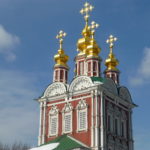
The museums and historical sites, like UNESCO designated Novodivechy and Kolomenskoye, are either in top shape or being refreshed/renovated. The Pushkin Museum collection of western art was, to our eyes, as well-lit and well-maintained as any we have seen elsewhere. The same was true of the the ancient cathedrals in the Kremlin and Red Square itself, where St. Basil’s, with its ten domes topping separate churches or chapels, now welcomed visitors inside.

Gum has become a huge mall, full of fancy shops and restaurants, rivaled by the huge building of Tsum department store nearby at the Bolshoi and by another three level mall beneath an adjacent plaza.
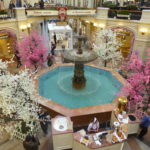
On the streets, snow was removed or shoveled neatly to the sidelines no matter where you walked in town. Buildings along major roadways and side streets seemed in fine shape. Traffic – a mix of old rusting cars and newer models, with plenty of BMWs and Mercedes among them – could be snarled up on even the smallest streets. The main thoroughfares could see the same thing, but surprisingly most moved briskly.
Police and security
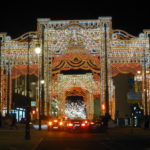
In a few days, we couldn’t discover much about personal freedoms aside from economic ones. You certainly don’t feel you’re in a police state. Immigration requires registering your location if you’re a foreigner, but only if you stay at the same place for over a week. We had similar requirements in France about a decade ago. And free healthcare is available only within the district where you reside, so there are some pragmatic limits on freedom to move. There was what we consider now very typical security screening upon entering museums and institutions. Similar setups at stores and metro seem more formulaic or potential, as the indifferent security personnel pay little attention to them. On the street, there are beat cops evident. Within the Kremlin and other governmental spaces, at least someone keeps an eye out, but you’ll see the same all over Europe and often in the USA.
People

As those cars and phones suggest and the plentiful malls like GUM or high-end shops demonstrate, there is great wealth in Moscow. We didn’t enter any stores in GUM, but the café-bistro looking out on St. Basil’s was pleased to offer a glass of wine for $12. Even on the streets brands like Cartier, Bulgari and such offer high end glitter. Yes, they cater to tourists, but we saw plenty of swanky Muscovites in them as well. Appealing pubs, cafes, even vegetarian restaurants are available. Local cafe chains competed with Starbucks everywhere. The one we tried welcomed a host of young, and a few middle-aged, Russians. When not on their phones, they were smiling and engaged with each other.
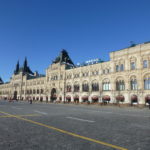
People walking the streets seemed busy, but hardly dour. The 20- and 30-somethings, as well as school-children, seemed quite jolly. We saw a few beggars, near the tourist spots and along some streets, some with deformities and some just old. These were not good conditions for them, but happily no worse than NYC or most other US cities.
Even beyond the second ring of the town, at a few suburban town centers, we saw the streets lively with neon-signed stores and services. Optimistic hawkers promoted services with flyers and offered street food. Well-dressed residents, including mothers with carriages or children in tow despite the below freezing temperatures, filled the intersections and streets, or walked briskly through the parks near the Moscow River. People gabbed happily as they moved, or stopped often for street conversations despite the cold. Russians, we observed, are still hardy despite inclement conditions or troubles. Their apartment buildings, Soviet era style, were plain but functional – but not apparently deteriorating.
The many residents we met, whether at shops or chance encounters, were uniformly friendly and pleasant, helpful despite our bumbling Russian – well, except for that brusque, irritable young woman at the Pushkin Museum café. That we were Americans intrigued them, rather than raised any barriers. Several were very eager to talk with us, even about politics – happy to practice a bit of English with us.
One neatly dressed young man explained how things were not so good in Russia with Putin. Everything was expensive in light of their salaries. So it’s tough making ends meet for the service workers (though we are well aware how true this can be in the US as well). He openly expressed doubts about Putin’s popularity despite the overwhelming vote for his next term a few days before. No opposition, ballot stuffing…”What can you do?” he shrugged.
Yet the critiques regarding daily life were balanced by an appreciation of Putin’s strong actions in foreign affairs. Our shopkeeper praised how strong and successful he has proved in Syria. He started feeling us out about our President Trump. Though we were politely negative, he held back except to suggest that there was another strong independent leader, though perhaps not one even he agreed with.
One woman explained some other details of daily life. For affordability, many lived far out of the central city, and needed long commutes to work. And traveling even across Russia to Lake Baykhal, as we were about to do, was an expense she could not imagine at this time. But she affirmed something we guessed: heating sources, mostly oil, were cheap – or a lot more people would have trouble surviving the Moscow winters…and residents like things warm inside. And she took for granted the availability of schooling and healthcare for all citizens, though for some reason an appointment at the end of the month was more difficult to secure.
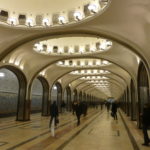
Back down in the Metro, what we most noticed was ordinary – the typical dogged look of commuters, some polite and some who push their way past you – a tall woman who looked like a model barreled through us and settled into a spot opposite the door, her bare head bent over her phone, oblivious to what surrounded her. Most wear the winter uniform of big cities, hefty coats, warm caps and scarves in muted colors, and perhaps somewhat better dressed than in NYC. We crowded in with a few voluble groups, but mostly just saw people going on with their business – half asleep, busy with phones connected to that free wi-fi, reading or – in one case – correcting exam papers. Just preoccupied, getting on with life.
(Also, for more pictures from Russia, CLICK HERE to view the slideshow at the end of the itinerary page.)


